This easy recipe for fresh, homemade basil pesto sauce, is adapted from Andy Baraghani via Bon Appétit and only has 5 simple ingredients. I'll tell you how to use it, store it, and freeze it! Make it in a food processor in 15 minutes.

There's nothing like fresh basil pesto sauce. You can use it with everything from a simple pesto pasta to homemade gnocchi, and it's a great way to make your basil last longer if you have a bunch of it in the garden.
I'll make pesto out of anything I can, including kale pesto and sage pesto, but this is the classic Italian recipe that you know and love. It's the one that started it all, but with a unique method from Bon Appétit that keeps the basil just as green as it can be.
Jump to:
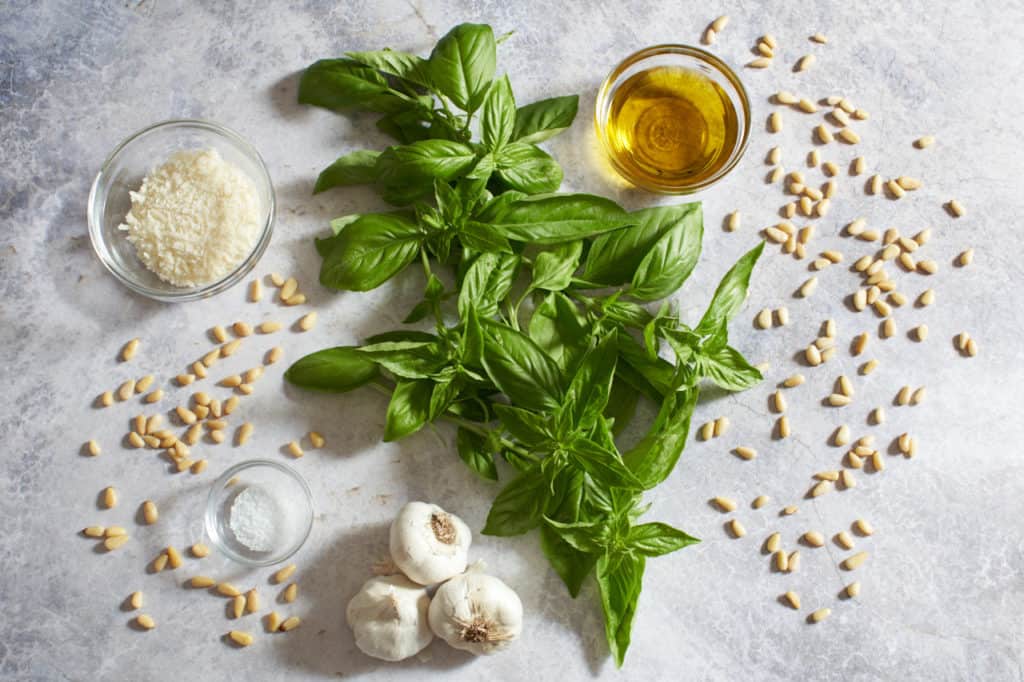
Pesto sauce ingredients
- Fresh basil: If you can get fresh basil from your own garden or the farmer's market that is best. (Basil grows well in a pot on your porch or windowsill - give it a try!) If not, regular ol' basil from the produce section will do.
- Parmesan cheese: I recommend using real parmesan cheese (Parmigiano Reggiano) and grating it yourself. The flavor is so much better. You can also use Grana Padano cheese.
- Pine nuts: Pine nuts, or pignoli in Italian, give pesto a creamy richness. They can be expensive, but you can make pesto with pistachios, walnuts, almonds, or hazelnuts, too.
- Extra virgin olive oil: Use a good olive oil, because this is going to be a major flavor component. Try one that you would want to dip bread into, or make a vinaigrette with, as opposed to one you would use to sauté vegetables.
- Garlic and salt: Just a couple of cloves of garlic and a bit of salt bring the flavors together.
*Ingredients with measurements are listed in the recipe card below.
How to make basil pesto sauce

Step 1: In a dry skillet, toast the pine nuts over medium heat until they are lightly golden and becoming fragrant. Set aside to cool, and in the meantime, grate the parmesan cheese on a box grater.

Step 2: Once they have cooled, put the toasted pine nuts in a food processor. Use a microplane grater to grate the garlic and add to the pine nuts, then process until they are finely ground.
Want to save this recipe?
You'll join hundreds of readers on my email list!
Tip: Grate your own cheese for the best flavor
I always prefer to grate my own cheese, as pre-grated parmesan can get dried out and it's often coated with anti-caking agents. Grating it yourself will ensure that the pesto sauce has the best flavor and texture.
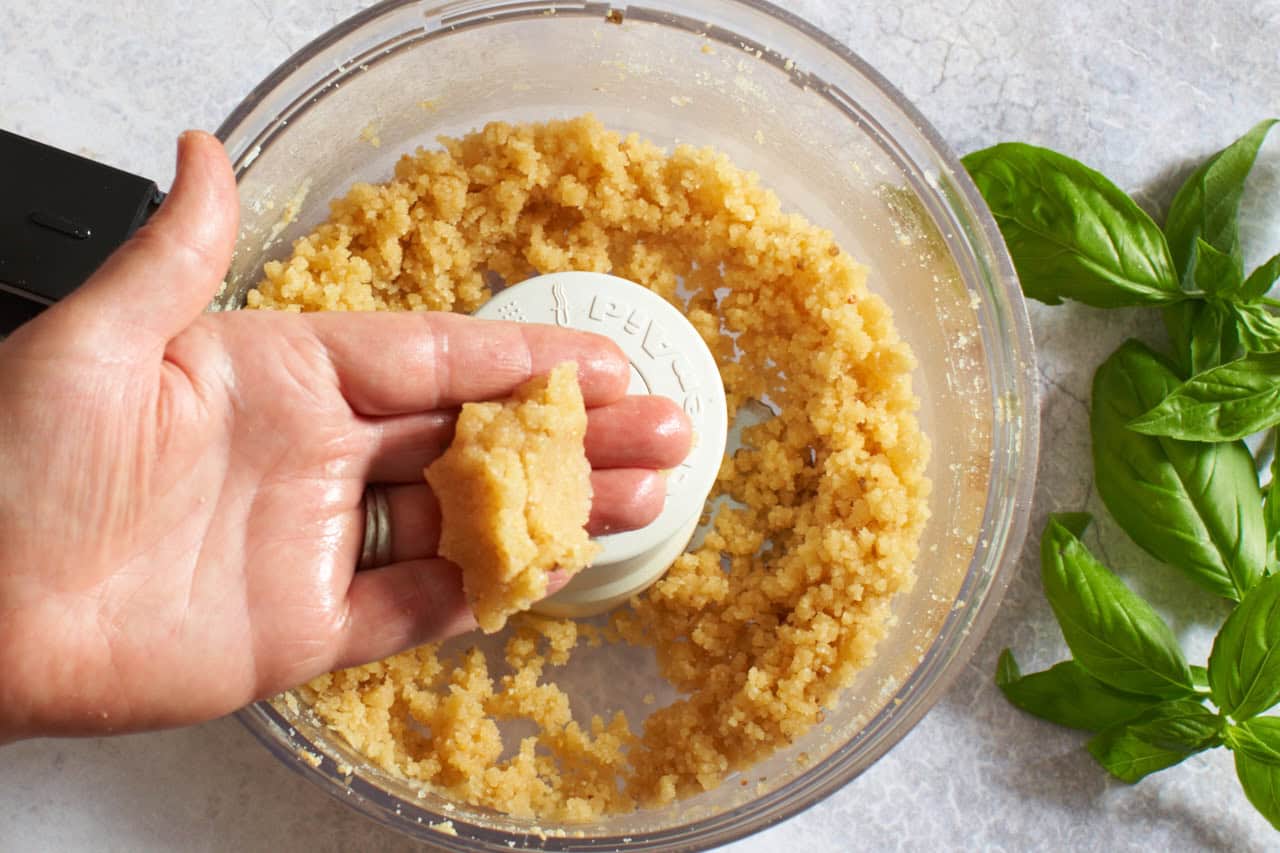
Step 3: Add the parmesan cheese and process until the mixture is clumping together. You should be able to squeeze it into a ball with your hands like dough.
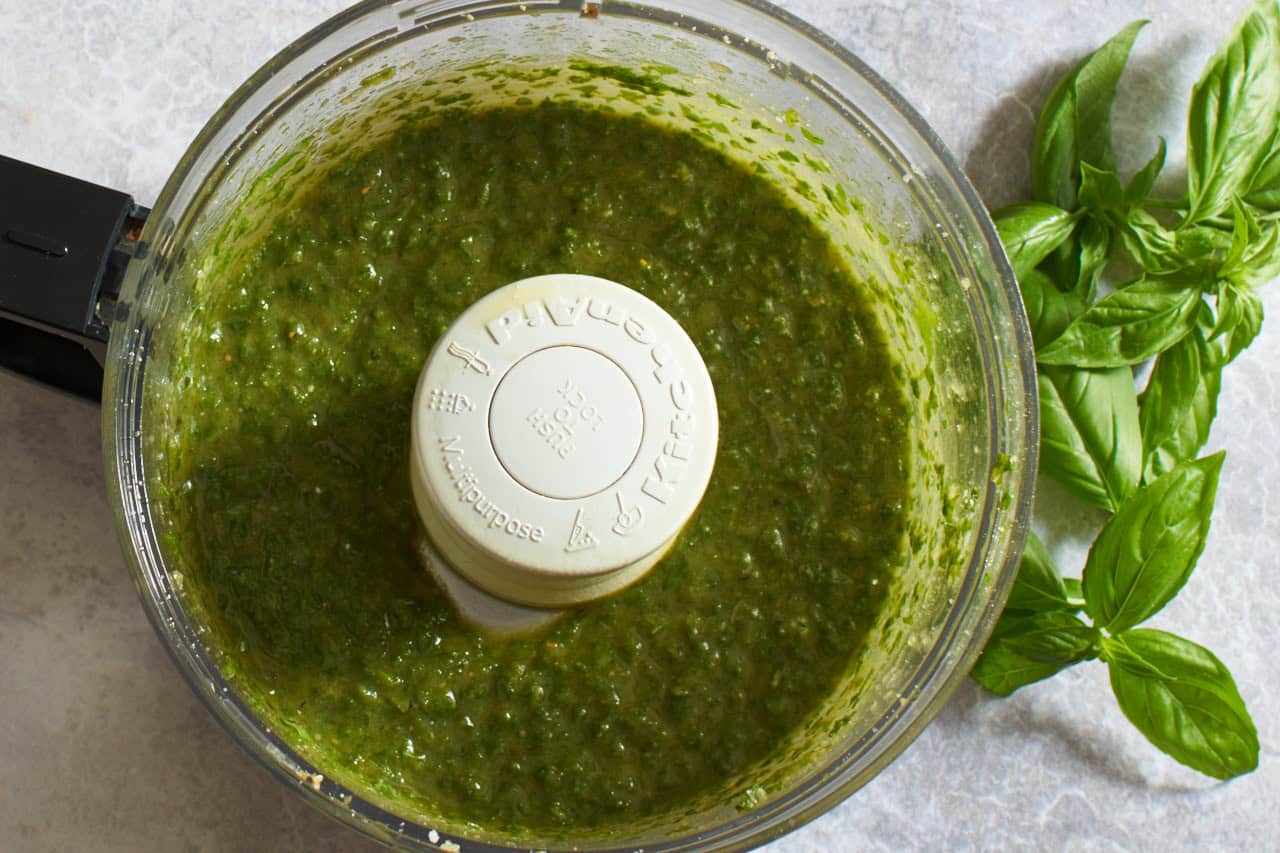
Step 4: Add the basil, salt and about ¼ cup of olive oil, pulse a few times to break up the leaves. With the processor running on low, drizzle in the remaining olive oil just until the basil leaves are finely chopped and the mixture is smooth. Don't over process.
Expert tips
- Never store fresh basil in the refrigerator: This can cause it to turn brown. When I cut basil from my garden, I put it in a glass of water and keep it on the counter. (It will actually keep growing like this if you let it.) This method doesn't work as well for me with store-bought basil, so I put it in a cool spot on the counter (away from the oven/stove) and use it within 24 hours.
- Make sure the basil leaves are completely dry: Before you make your pesto sauce, be sure the basil leaves are dry. Olive oil and water don't mix, and if the leaves are wet, the texture and consistency will not be correct.
- Don't over-process: The blades of the food processor create heat and that can discolor the basil leaves. Process just until you have reached the right consistency and then shut off the motor. That's the whole point of this method of grinding down the pine nuts first, so that you're not beating up that basil the entire time.
- Substitute other cheeses: If you're lactose intolerant, try making pesto with pecorino romano—a sheep's milk cheese—or aged goat cheese. Just check the salt level when substituting cheeses, if they are very salty you'll need to use less kosher salt.
- Do not heat up pesto: It can be added to warm things like pasta noodles or soups, but you don't want to simmer it on the stove because the basil will discolor and lose its fresh flavor.
Storage and freezing
- To store: Place in an airtight container and add a thin layer of olive oil over the top before you put the lid on to keep the sauce nice and green. It will keep in the refrigerator for at least 5 days.
- To freeze: Freeze pesto sauce in silicone ice cube trays, zip top storage bags, or reusable silicone storage bags. I use ice cube trays—any size works—and once frozen, transfer them to a sealed freezer-safe container. Then you can easily add cubes of pesto to recipes in different amounts as you need them.
How to use basil pesto
- Pesto potato salad is a light, summery version of the classic recipe perfect for backyard parties.
- Stir it into mayo or use on its own to spread on sandwiches.
- Drizzle your homemade pesto on top of cooked pizzas or flatbreads, or serve on the side with crispy potatoes.
- Stir pesto into soup recipes when serving, or use it as a dipping sauce for bread or dinner rolls.
Debra's Details: Homemade basil pesto sauce is fresh and easy!
- Pesto sauce uses mostly basic pantry ingredients that you probably already have, just pick up some fresh basil and pine nuts.
- This food processor method from Bon Appétit ensures great texture and it's quick!
- Use basil pesto in pastas, soups, on sandwiches, and more!
- Pesto sauce freezes well for up to three months!
If you enjoy this recipe, please leave me a 5-star rating ⭐️⭐️⭐️⭐️⭐️ in the recipe card! It really helps others find my content and helps my business grow! Sign up for my newsletter for recipes delivered to your inbox and follow me on Instagram and Pinterest! Thank you!
Recipe
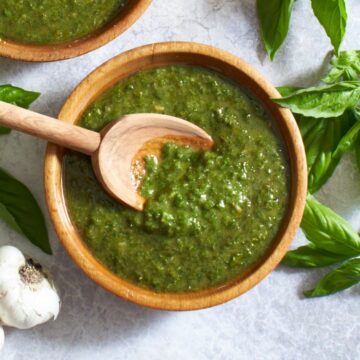
Bon Appétit Basil Pesto Sauce Recipe
Equipment
- box grater (optional)
Ingredients
- ½ cup pine nuts
- 2 cloves garlic
- 3 ounces grated parmesan cheese
- 6 cups fresh basil
- 1 cup extra-virgin olive oil
- 1 teaspoon kosher salt
Instructions
- Put the cooled pine nuts in a food processor. Use a microplane grater to grate the garlic, and add to the food processor with the pine nuts.
- Process the pine nuts until they are very finely ground.
- Add the parmesan cheese and process until the mixture is clumping together. You should be able to squeeze it into a ball with your hands like dough.
- Add the basil and salt to the food processor along with about ¼ of the olive oil and pulse a few times to break up the leaves. Then with the processor running on low, drizzle in the remaining olive oil just until the basil leaves are finely chopped and the mixture is smooth. Don't over-process.
Want to save this recipe?
You'll join hundreds of readers on my email list!
Notes
- Don't store fresh basil in the refrigerator: This can cause it to turn brown. When I cut basil from the garden, I put it in a glass of water and keep it on the counter. (It will actually keep growing like this if you let it.) This method doesn't work as well for me with store-bought basil, so I put it in a cool spot on the counter (away from the oven/stove) and use it within 24 hours.
- Make sure the basil leaves are completely dry: Olive oil and water don't mix!
- Don't over-process: The blades of the food processor create heat and that can discolor the basil leaves. Process only until you have reached the right consistency and then shut off the motor.
- To store pesto in the refrigerator: place in an airtight container and add a layer of olive oil over the top before you put the lid on to keep the pesto nice and green underneath. It will keep for at least 5 days.
- To freeze: I like to freeze pesto in large silicone ice cube molds so I can freeze it in portions. Then I transfer them to a freezer bag. Pesto keeps in the freezer for up to three months.
Nutrition
Nutrition information is automatically calculated as an estimate. Calorie accuracy is not guaranteed.

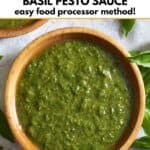
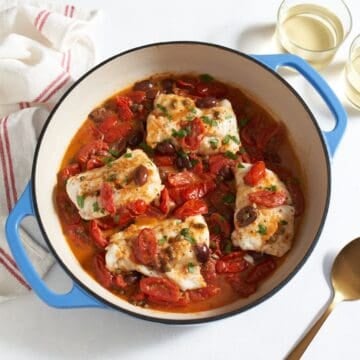
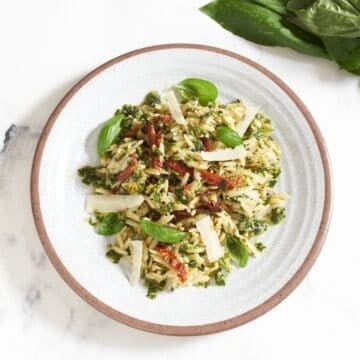
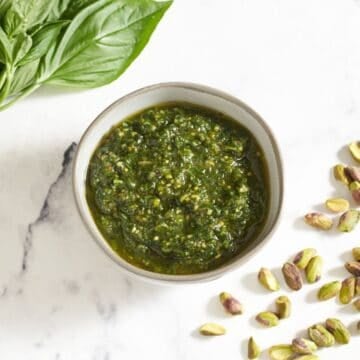

Leave a Reply